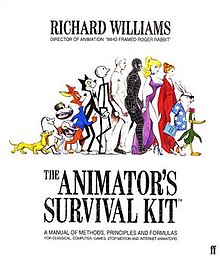The Animator's Survival Kit
 Original edition cover | |
| Author | Richard Williams |
|---|---|
| Cover artist | Richard Williams |
| Country | United States |
| Language | English |
| Genre | Animation, Instruction |
| Published | 2001 (Faber and Faber) |
| Pages | 379 |
The Animator's Survival Kit: A Manual of Methods, Principles, and Formulas for Classical, Computer, Games, Stop Motion, and Internet Animators (ISBN 0-5712-0228-4) is a book by award-winning animator and director Richard Williams, about various aspects of animation.[1] The book includes techniques, advice, tips, tricks, and general information on the history of animation. It has been praised by many[who?] as one of the best books on animation available.[1]
DVDs[edit]
Animation examples from the book combined with footage from Richard Williams' masterclasses have been put into a 16-volume DVD box set titled The Animator's Survival Kit – Animated.[2] The logo from the book cover was completely animated in the traditional style, taking Williams and his animators 9 months to complete. Williams also included some early drafts of his own work from previous projects.[citation needed]
Reception[edit]
The book met with universal acclaim. Chris Wedge, the director of Epic and Ice Age, wrote about the book: "What I came out with was a complete re-structuring of animation, how I saw animation, how I analysed motion. People the first night sat down at their work stations and were running some of Richard's examples ... and at lunchtime you could see the influence. It was a revelation."[3] The book has become incredibly popular in the animation industry and is commonly used by animation students worldwide.[citation needed]
See also[edit]
References[edit]
- ^ a b Nass, Paul. "Review of The Animator's Survival Kit". Retrieved 2008-04-20.
- ^ "The Animator's Survival Kit - Animated". Foyles. Retrieved October 17, 2009.
- ^ [1]
External links[edit]
| This article about a non-fiction book on film is a stub. You can help Wikipedia by expanding it. |
| This animation-related article is a stub. You can help Wikipedia by expanding it. |